Nothing beats the flavor and freshness of herbs picked straight from your own garden—especially when that garden lives right inside your kitchen. Imagine cooking a steaming bowl of pasta and reaching for a handful of fresh basil, or brewing mint tea with leaves plucked from your windowsill. An indoor herb garden brings this freshness within arm’s reach, while also adding greenery and a soothing aroma to your space.
Creating a mini indoor herb garden in your kitchen is not only easy but also deeply rewarding. With a bit of planning, the right setup, and regular care, you can grow lush, fragrant herbs year-round—even without a backyard. This article will walk you through every step—from selecting herbs and containers to lighting, watering, and maintenance—so your indoor herb garden thrives beautifully.
Why Grow Herbs Indoors?
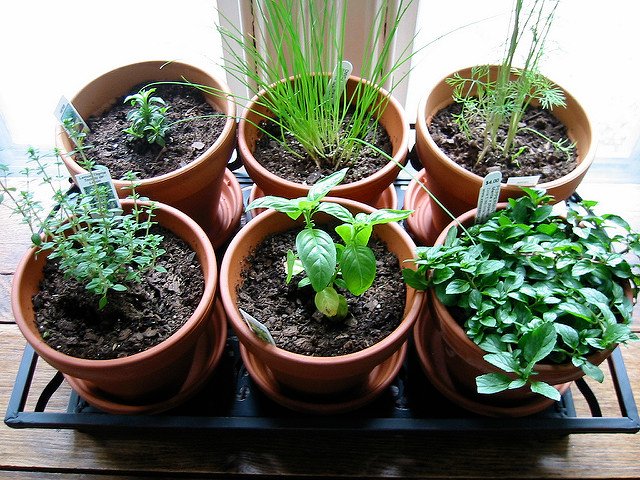
Indoor herb gardening has become increasingly popular among home cooks, plant lovers, and urban dwellers alike. The reasons are simple:
- Freshness All Year: You can harvest herbs anytime, regardless of the season.
- Convenience: Everything you need is within reach while cooking.
- Space-Saving: Even small kitchens can host a thriving mini garden.
- Air Purification: Herbs like mint and parsley naturally purify indoor air.
- Aesthetic Appeal: Greenery brightens up the kitchen, creating a calming and beautiful atmosphere.
- Sustainability: Reduces reliance on store-bought herbs wrapped in plastic, cutting waste.
Choosing the Right Herbs for Your Indoor Kitchen Garden
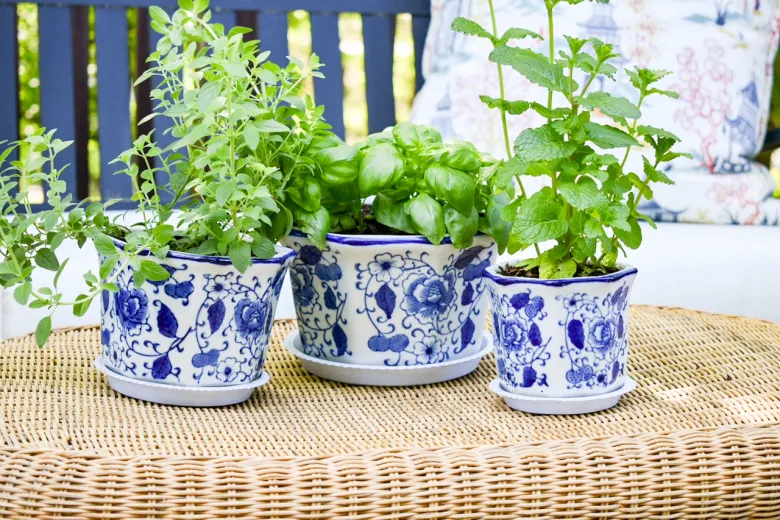
Not all herbs grow equally well indoors. Some need more sunlight or space than others. The best choices are compact, adaptable species that thrive in moderate light and humidity—conditions typical of most kitchens.
Top Herbs to Grow Indoors
- Basil: Loves warmth and bright light. Ideal for Italian dishes, salads, and sauces.
- Mint: Easy to grow and great for teas, desserts, and refreshing drinks.
- Parsley: A versatile herb for garnishes and savory dishes.
- Chives: Adds a mild onion flavor to soups and omelets.
- Thyme: A hardy herb that tolerates drier soil and moderate light.
- Rosemary: Aromatic and woody; great for roasting and Mediterranean recipes.
- Cilantro: Fast-growing but prefers cooler conditions.
- Oregano: A sun-loving herb perfect for pizzas and pastas.
Tip: Start with 3–5 easy herbs that suit your cooking habits and gradually expand as you gain confidence.
Selecting the Perfect Spot in Your Kitchen
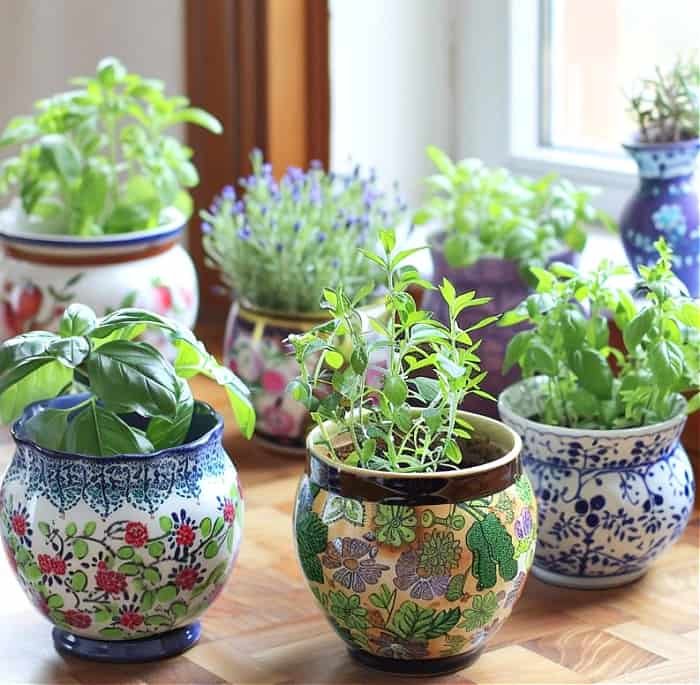
Herbs thrive when they receive at least 4–6 hours of sunlight daily. The best spots for your indoor herb garden include:
- South- or West-Facing Windowsills: These offer the most sunlight.
- Countertops Near Windows: Great for easy access and natural light.
- Hanging Planters or Vertical Racks: Perfect for small kitchens with limited space.
If your kitchen doesn’t get much sunlight, don’t worry—grow lights can easily make up for it. LED grow lights mimic natural sunlight, providing the right spectrum for healthy herb growth. Position them 6–12 inches above the plants and keep them on for 10–12 hours daily.
Choosing Containers and Planters
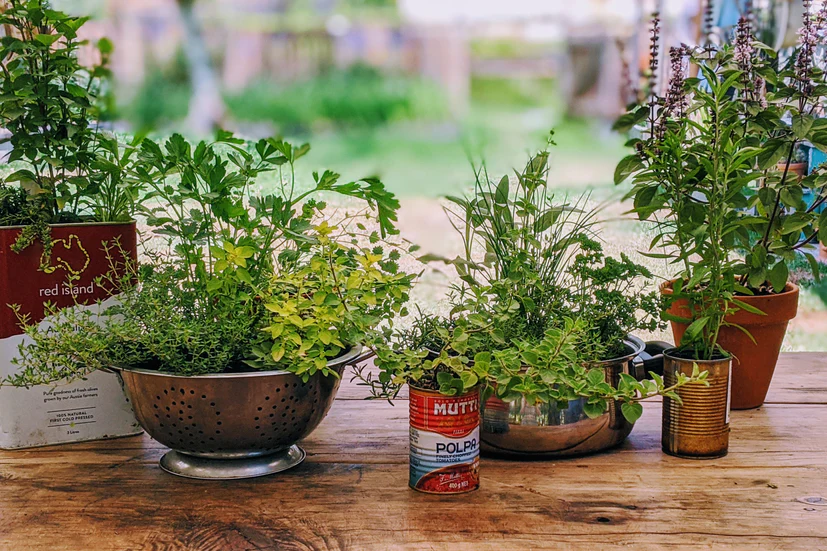
The right container makes a big difference in plant health and aesthetics. Here’s what to keep in mind:
1. Drainage is Essential
Always use pots with drainage holes to prevent water from accumulating, which can lead to root rot. If your decorative containers lack holes, place a plastic liner pot inside that can be removed for watering.
2. Size and Material
- Small Pots (4–6 inches): Great for single herbs.
- Long Planters or Window Boxes: Ideal for growing multiple herbs together.
- Material Options:
- Terracotta – breathable but may dry out quickly.
- Ceramic – retains moisture and looks decorative.
- Plastic – lightweight and affordable.
3. Creative Ideas
You can repurpose mason jars, tin cans, or teacups as charming herb planters—just ensure proper drainage.
Selecting the Right Soil
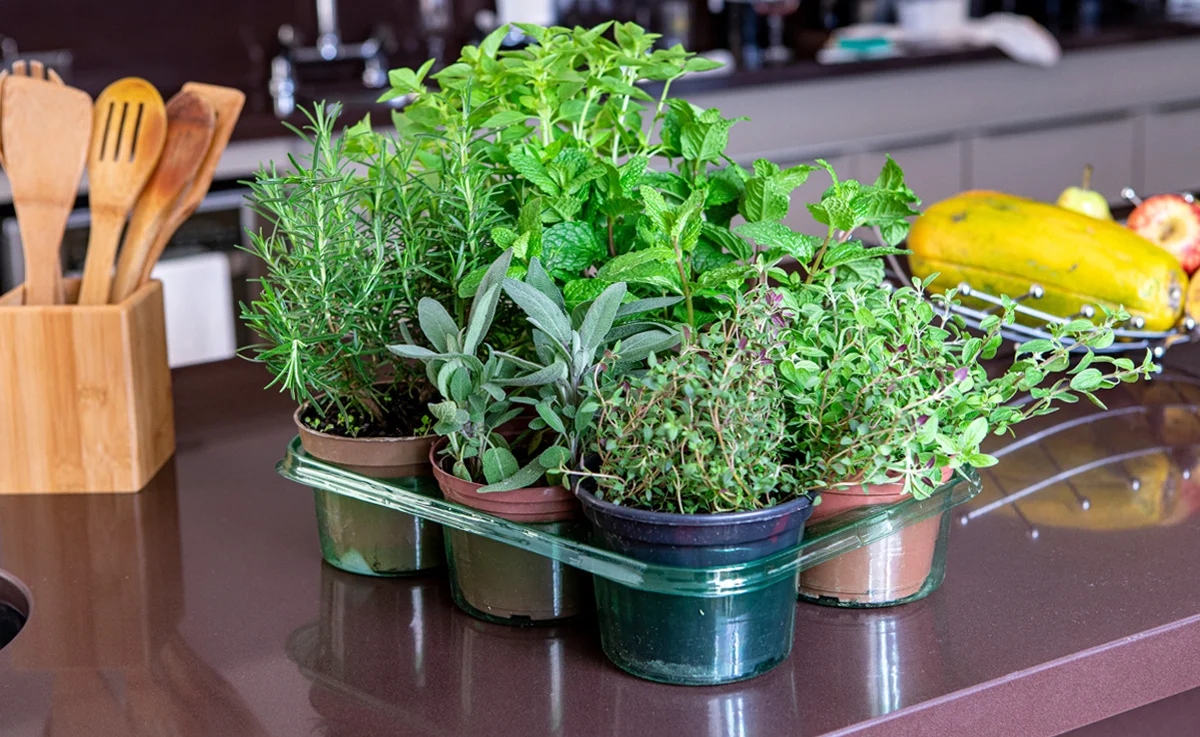
Herbs prefer well-draining, nutrient-rich soil. Avoid using regular garden soil—it’s too dense and may contain pests. Instead, opt for:
- Potting Mix: A lightweight, sterile mix designed for indoor plants.
- Herb-Specific Mix: Often includes perlite or vermiculite for better aeration.
For extra drainage, place a small layer of pebbles or broken pottery at the bottom of each pot before adding soil.
Planting Your Herbs
You can start your indoor herb garden from seeds, cuttings, or small nursery plants.
From Seeds:
- Fill your pots with soil, leaving about an inch at the top.
- Sprinkle seeds evenly on the surface.
- Lightly cover with soil and mist with water.
- Keep the soil consistently moist until seeds sprout (usually 7–21 days).
From Cuttings:
Some herbs, like mint, basil, and oregano, root easily from stem cuttings.
- Snip a 4–6 inch stem below a leaf node.
- Place it in a glass of water near a sunny window.
- Once roots appear (in 1–2 weeks), transfer to soil.
From Nursery Plants:
This is the fastest way to start. Simply transfer herbs from store-bought pots to larger containers with fresh potting mix.
Watering and Humidity Needs
Proper watering is one of the most crucial aspects of indoor herb care.
- Check Before You Water: Stick your finger an inch into the soil—if it’s dry, it’s time to water.
- Avoid Overwatering: Too much moisture suffocates roots.
- Use a Tray or Saucer: Collect excess water and prevent messes.
- Humidity: Most herbs appreciate moderate humidity. Mist leaves occasionally or use a pebble tray filled with water to maintain moisture around plants.
Tip: Herbs like rosemary and thyme prefer slightly drier soil, while basil and parsley enjoy more consistent moisture.
Fertilizing Indoor Herbs
Herbs grown in pots need nutrients replenished regularly since water leaches minerals from the soil.
- Use a diluted liquid fertilizer (half-strength) every 3–4 weeks during the growing season.
- Organic options include compost tea, worm castings, or fish emulsion.
- Avoid over-fertilizing—it can cause excessive leaf growth with weaker flavor.
Pruning and Harvesting for Healthy Growth
Regular pruning not only provides fresh herbs for cooking but also encourages bushier, fuller plants.
How to Prune Properly:
- Use sharp scissors to snip above a leaf node (the point where leaves emerge).
- Never remove more than one-third of the plant at a time.
- Pinch off flower buds (especially on basil) to keep leaves tender and flavorful.
Harvesting Tip: Pick herbs in the morning when their essential oils are most concentrated for the best flavor.
Lighting Solutions for Every Kitchen
If your kitchen doesn’t receive enough natural sunlight, you can use artificial grow lights to keep herbs happy.
Types of Grow Lights:
- LED Grow Lights: Energy-efficient and long-lasting, suitable for all herbs.
- Fluorescent Bulbs (T5 or T8): Great for small herb setups.
- Clamp Lights or Under-Cabinet Lights: Convenient for countertop gardens.
Keep the lights about 6–12 inches above the herbs and on for 12–14 hours daily to mimic sunlight.
Creative Herb Garden Ideas for Small Kitchens
Even if you have limited counter space, there are plenty of ways to fit a mini garden into your kitchen.
1. Vertical Herb Garden
Use a tiered shelf, wall-mounted pots, or hanging planters to save space and display herbs beautifully.
2. Windowsill Garden
Perfect for kitchens with good sunlight—place small pots of basil, parsley, and mint along the ledge.
3. Hanging Mason Jars
Suspend mason jars with twine or metal holders near a bright window for a rustic look.
4. Magnetic Pots
Attach small magnetic pots to your refrigerator or metal backsplash to hold lightweight herbs.
5. Rolling Herb Cart
Use a tiered rolling cart that can be moved around for light and easy watering access.
Common Problems and How to Fix Them
| Problem | Possible Cause | Solution |
|---|---|---|
| Yellow leaves | Overwatering | Let soil dry out before watering again |
| Weak, leggy stems | Too little light | Move closer to window or add grow light |
| Dry, crispy leaves | Low humidity | Mist regularly or use humidifier |
| Slow growth | Nutrient deficiency | Apply light fertilizer monthly |
| Pests (aphids, gnats) | Poor air circulation | Wipe leaves and use neem oil spray |
Maintaining Your Indoor Herb Garden Year-Round
- Rotate Pots: Turn them every week for even light exposure.
- Re-pot Annually: Refresh soil and trim roots to prevent overcrowding.
- Clean Leaves: Gently wipe dust from leaves with a damp cloth to improve photosynthesis.
- Watch for Signs: Drooping leaves or stunted growth are early signs of stress—adjust water, light, or feeding accordingly.
Final Thoughts
Creating a mini indoor herb garden in your kitchen is more than just a gardening project—it’s a lifestyle upgrade. It brings nature into your daily routine, enhances your cooking, and adds tranquility to your home.
With a little care, your kitchen can become a living, aromatic sanctuary filled with vibrant greens and fresh fragrances. From basil’s sweet aroma to mint’s refreshing scent, each herb you nurture brings flavor, health, and beauty to your space.
So, start small—choose a few herbs you love, find them a sunny spot, and watch your indoor garden thrive. Soon, you’ll wonder how you ever cooked without it.
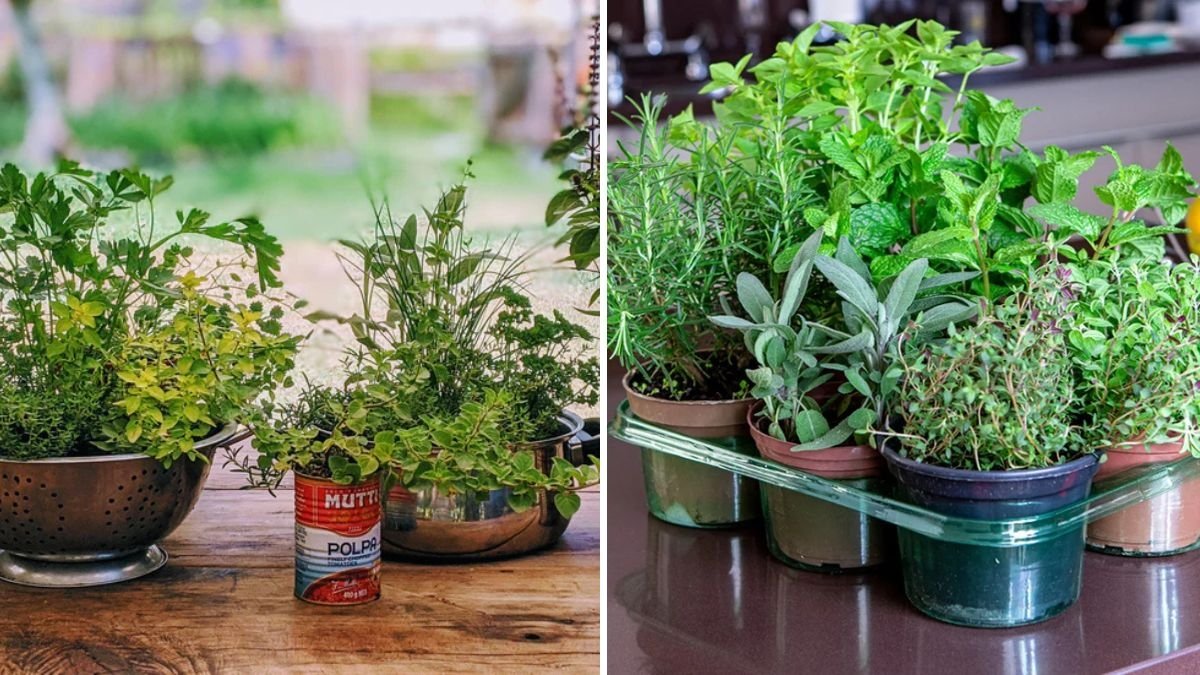




Leave A Comment